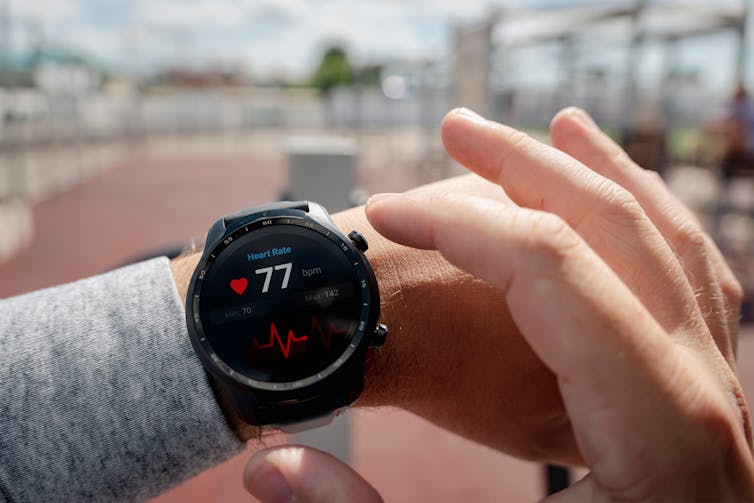The hardest part of any workout regime is sticking with it. Around half of those who start an exercise programme stop within six months.
But our recent study found that using wearables (such as a smartwatch) not only makes people more likely to start working out, they’re also seven times more likely to still be active after six months compared to those who didn’t use a smartwatch.
Our study focused specifically on adults who had recently been diagnosed with type 2 diabetes. Physical activity is a cornerstone of type 2 diabetes management, as it helps regulate blood sugar, supports cardiovascular health and improves quality of life.
Yet around 90% of people with type 2 diabetes fall short of weekly physical activity recommendations. Common barriers include low motivation, uncertainty about what activity is safe and a lack of tailored support.

Get your news from actual experts, straight to your inbox. Sign up to our daily newsletter to receive all The Conversation UK’s latest coverage of news and research, from politics and business to the arts and sciences.
Our study tested a new approach using wearable technology and remote coaching to overcome these barriers. We found that people who followed a smartwatch-supported remote coaching programme were ten times more likely to start a workout regime than those who received remote coaching alone.
The study involved 125 adults aged between 40 and 75 from the UK and Canada who had recently been diagnosed with type 2 diabetes. All participants worked with an exercise specialist to co-design a personalised six-month physical activity plan. The focus was on gradually increasing both moderate-to-vigorous exercise (with a target of 150 minutes per week) and daily lifestyle activity. Support was delivered remotely through phone or video calls.
Half of the participants were randomly assigned to use wearable technology to support their personalised activity plans. The smartwatch had movement and heart rate sensors, a mobile app to track activity and personalised text messages based on their recent progress. They could also message their coach, receive real-time feedback and adjust their activity plans accordingly.
The results were striking. Compared to the control group, those who were given a smartwatch were ten times more likely to start working out regularly, seven times more likely to still be active after six months and three times more likely to remain active one year later – even after support had ended.
At the end of the programme, over 50% of the smartwatch group were meeting recommended activity levels. In comparison, only 17% of the control group were.
Feedback from participants showed that the flexibility of plans, personalised messages and smartwatch data were key motivators. While some faced early challenges with the technology, most adapted quickly.

Melnikov Dmitriy/ Shutterstock
These findings support growing evidence that wearable technology can help people become – and stay – more active. While our study focused on people with type 2 diabetes, similar benefits have also been observed in the general population.
For example, one trial found that inactive adults (aged 45-75) who were given pedometers and walking advice increased their daily step count by around 660 steps after 12 weeks compared to a control group. Those given a pedometer were also more active three years later.
Since then, wearable technology has advanced. Modern smartwatches now capture a wider range of metrics beyond steps – such as heart rate and activity intensity. A 2022 systematic review and meta-analysis, which analysed more than 160 randomised controlled trials, found that fitness trackers and similar devices were effective at increasing physical activity by an average of around 1,800 steps per day. Importantly, the most sustained improvements occurred when wearables were paired with personalised feedback or behavioural support.
Together, these studies suggest that wearables can be powerful tools for long-term behaviour change and may help us better stick to our fitness goals.
Wearable fitness trackers can extremely helpful – but only if you use them purposefully. Our research, along with findings from other studies, shows that wearables are most effective when they help you apply proven behaviour-change strategies.
Here are some evidence-based tips to help you get the most out of your device:
1. Set realistic, specific goals
Plan exactly when and how you’ll move. Apps can help you set daily or weekly targets. Research shows that breaking down big, vague intentions – such as “get fit” – into small, concrete steps makes it easier to stay motivated and avoid feeling overwhelmed.
2. Schedule activity and stick to it
Use reminders or calendar prompts to build a regular routine. Consistency builds habits, and scheduled activity reduces the chance of skipping workouts due to forgetfulness or lack of planning.
3. Track your progress
Monitoring your activity helps you stay motivated and accountable. This feedback boosts motivation by showing that your efforts are making a difference, increasing your sense of control and accountability.
4. Use small rewards
Many devices include features such as badges or streaks, which reinforce progress. Celebrating small wins triggers feelings of accomplishment, which encourages you to keep going and helps build long-term habits.
5. Share with others
Whether it’s a friend or coach, sharing your progress can boost commitment. Knowing others are aware of your goals can increase motivation, provide encouragement, and help you overcome challenges.
6. The tracker is a tool, not the solution
It won’t change behaviour on its own. Its value lies in how it supports your goals and helps you build lasting habits.
These techniques don’t just encourage short-term change – they build motivation, self-belief and routine, which are key for maintaining healthy habits over time.
Our research shows that when wearable tech is used as part of a structured, supportive programme, it can make a real difference – especially for people managing health conditions such as type 2 diabetes. By combining wearable technology with personalised coaching and proven behaviour change techniques, you might just have a better chance of sticking with your physical activity goals.






























































